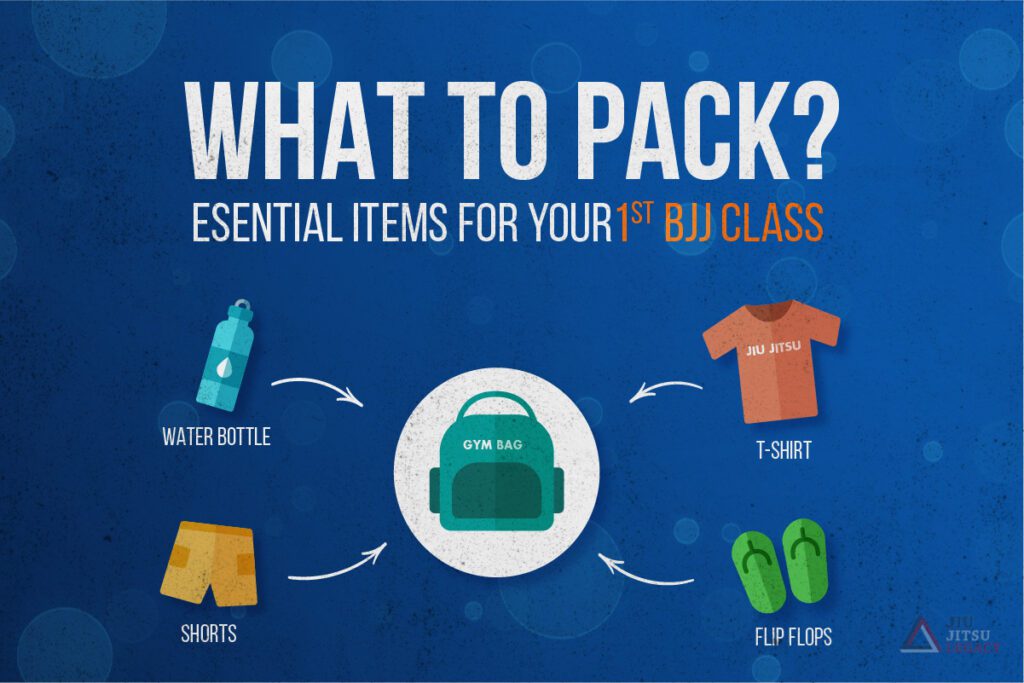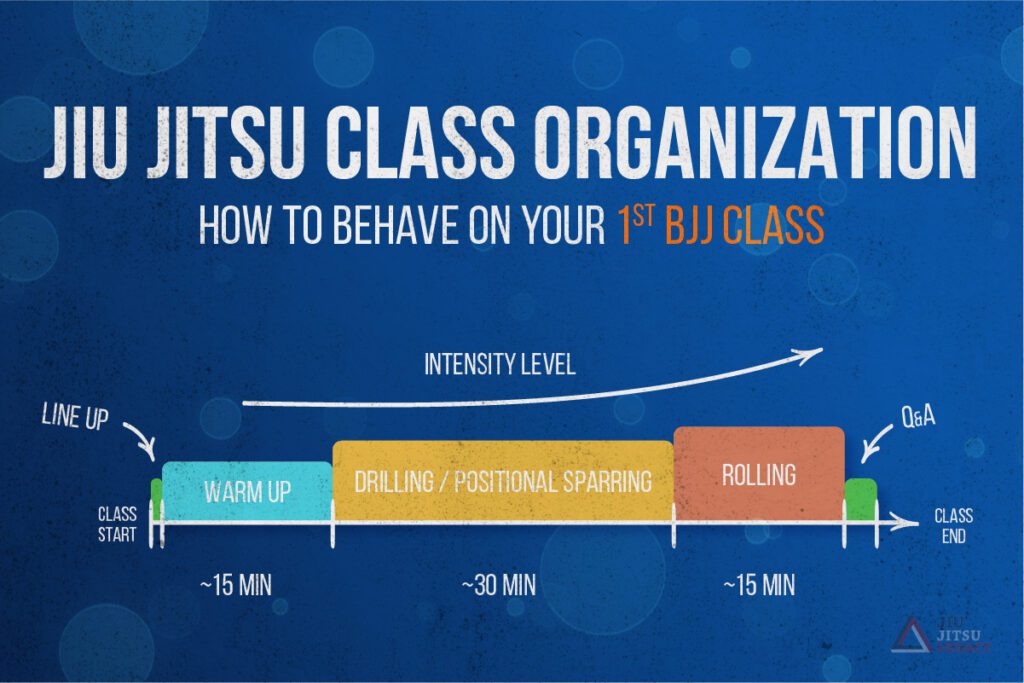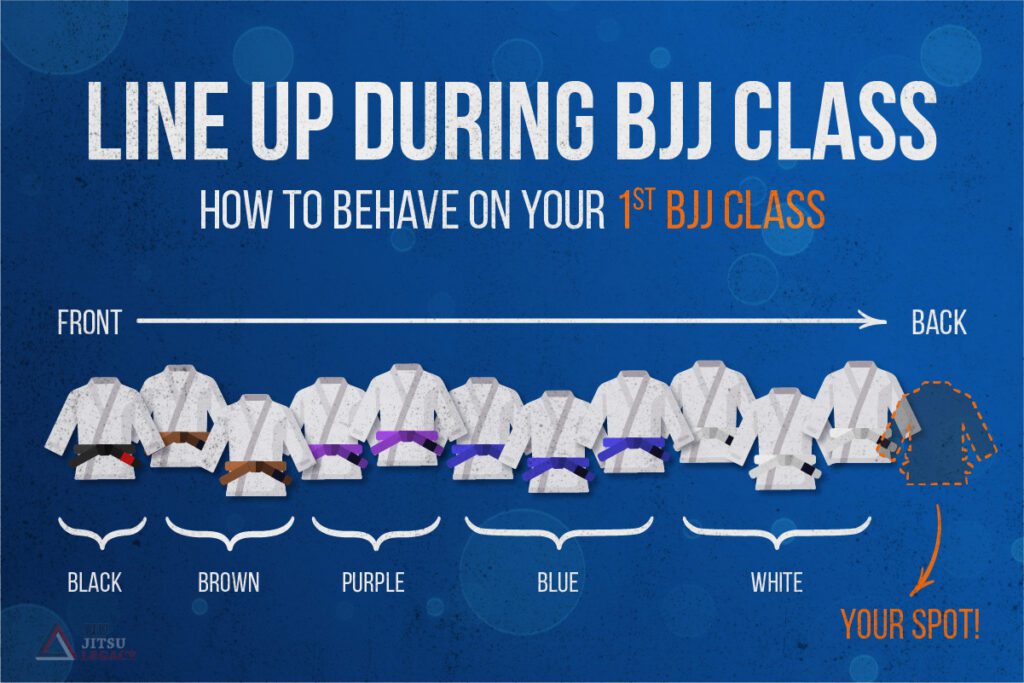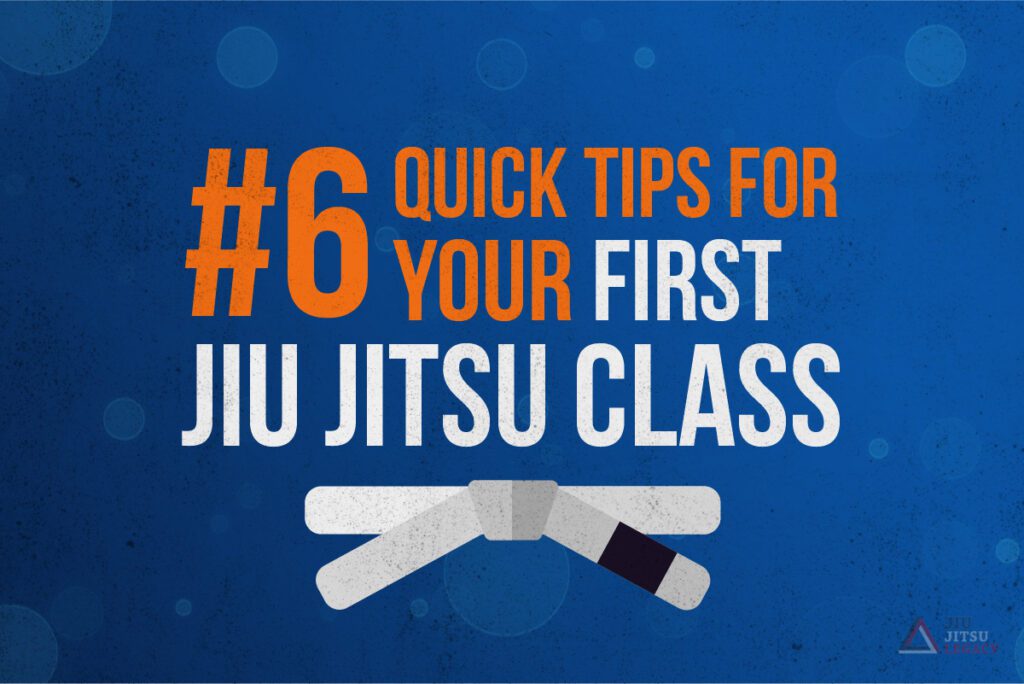If you are nervous about your first day of Brazilian Jiu Jitsu (BJJ) then here’s some good news: you don’t need to be nervous! BJJ is an enriching sport that will help you meet new people, get in shape, and build confidence. This cheat sheet has everything you need to know, so you can be prepared for your first day.
Preparation for Your First BJJ Class
Packing a gym bag is a good idea for your first day of BJJ. An essential item people forget on their first day is a water bottle. Jiu Jitsu is a physically intense martial art, so expect to be drenched in sweat by the end of class. You will find that you’ll need to hydrate after sparring or positional training!
What to Pack

- Water Bottle
- Flip Flops: You’ll need to wear footwear any time you have to leave the mat (for any reason). Flip-flops are quick and easy to put on and take off. When you go barefoot, you risk tracking bacteria back onto the mats that could lead to staph infection or ring worm.
- Change of Clothes: As mentioned earlier, expect to get sweaty. Driving home in sweaty clothes can be annoying, so fresh pants and a t-shirt are a great idea.
Hygiene
There is nothing that irritates BJJ practitioners more than poor hygiene. Long fingernails and toenails can feel like little thorns when you’re wrestling. Please keep your nails short, shower, so you smell nice (but skip the perfume or cologne!), and wear clean clothes. Many instructors tell their students not to come if they don’t have fresh equipment.
What to Expect?
Brazilian Jiu Jitsu is a submission grappling sport and martial art. On your first day, you should come prepared to wrestle. If you are out of shape, you might find this to be a little more physically intensive than you might expect. Wrestling someone for five minutes might feel like an eternity when you are trying to escape out from under them.
What to Wear?
For your very first day of class you should wear clothes you are comfortable working out in such as athletic shorts and a tight-fitting athletic shirt. Remember, Jiu Jitsu is a grappling martial art, so baggy clothes might get stretched. Also, don’t wear anything that might poke your partner, like belts, or anything that has buttons or zippers.
Things to Ask About
One thing you should ask prior to your first class is which class is best for beginners. Many gyms offer a fundamentals class that is beginner-friendly. It is also polite to ask your training partner if they have any injuries they would like you to know about before drilling or rolling.
Timing
Expect that your BJJ class will take at least an hour. If the class is No-Gi it might be wise to show up wearing your clothes you will use for class. Generally, the first fifteen minutes of class are used for warm-ups. Thirty minutes will be used for learning, and drilling. The final fifteen minutes are left for rolling.
At the BJJ Academy

Communication
One thing everyone needs to know before stepping on the mat is that questions are ok. Questions are even encouraged! If a technique is being demonstrated, any question that starts with “What if….?” and “What about…?” is probably a good idea to ask. Your instructor should appreciate that you are paying attention and thinking about the move. However, follow standard communication norms and don’t interrupt the professor, most of the professors dedicate a special time during the class and invite people to ask questions.
Arrival
It’s common practice to arrive fifteen minutes before class starts. Use this time to change into your training clothes or do some stretching. You might find people chatting quietly in circles on the mat before class. This could be a great opportunity to make friends.
Orientation
Every BJJ gym has different customs and traditions. Many gyms will line up before or after class with higher belts on one side and lower belts on the other, and “bow out” signaling the class is done. You might be surprised to learn BJJ is rather relaxed when it comes to traditions compared to other martial arts.
Jiu Jitsu Class Organization and Structure
A typical BJJ class consists of warm-ups, learning a technique, drilling, and rolling (sparring). The technique you learn, sometimes called the “move of the day,” could be any number of grappling concepts. You might learn how to escape out from under somebody bigger than you, or you might learn a submission hold.
Lining Up

Before class starts, the instructor might ask for students to line up against the wall. Most students order themselves by belt rank. The belt rank system is:
- White
- Blue
- Purple
- Brown
- Black
Warm Ups
Warm-ups for BJJ are normally light cardio and stretching drills that get you ready for class. BJJ has some unique warm up drills that you might not have seen or practiced before. Shrimping is probably going to be the one you notice first, and one you might feel silly doing. The purpose of these unique drills is to acclimate yourself to a new way of moving.
Technical Demonstrations: “Move of the Day”
As far as what’s covered in class, Jiu Jitsu is an ever expanding martial art. Some new practitioners might feel a little overwhelmed with how technical some of the moves seem. On your first day, don’t expect to remember every detail that was covered in class. As a fresh white belt, focus on the terms the instructor uses (ex. mount, side control) and ask questions.
Drilling / Positional Sparring
Soon after the instructor has demonstrated the technique, you will break off and start drilling the move with your partner. As a day one student, it would behoove you to see if you can partner with someone who has a color belt. Colored belts have likely seen this technique before, and will drill more smoothly. Don’t be afraid to drill slowly, and try to remember the steps.
Live Sparring (Rolling)
You might notice that the class actually starts moving faster towards the end. The final minutes of class are reserved for “rolling.” This is the term BJJ practitioners use for sparring. You and your partner will be given the green light to try and wrestle each other into a submission. This is many practitioners’ favorite part of class, and is what sets BJJ apart from other martial arts.
Some gyms won’t allow you to roll on your first class, while others will leave it up to you to decide if you’re ready.
After Class
After class, the instructor will generally ask if anyone has any final questions. It could be about the “move of the day” or anything in general. Maybe your partner put you in a strange position during rolling, and you would like to know how to escape. This time is also an opportunity to bond with your teammates.
6 Quick Tips for Your First BJJ Class

- Don’t Be Afraid to Tap! No one is going to make fun of you for being submitted. As a new white belt, it might be discouraging being submitted for your first time, but the goal is to stick with it and learn as much as you can. Remember, “To be a lion, you must train with lions.” – Carlson Gracie
- Tap Early, Tap Fast! Sometimes when someone has a submission hold on you, it might be tempting to try and fight out of it. While sometimes fighting out of a poorly applied submission is a good thing, on your first day it’s better to err on the side of caution.
- Don’t Wear Jewelry! Women, this means earrings. Men, this means no Whoop or Fitbit straps. It might be tempting to try and show your friends how much exercise you got, but these gadgets often fall off during training and are a nuisance.
- Drink Water! Always stay hydrated. BJJ will cause you to sweat and if you’re not hydrated before class you will feel exhausted.
- Don’t Eat a Large Meal Before Class! You hear mixed thoughts on this. Sometimes it might be good to have a light snack for energy, but in general a large meal before practice will be cumbersome.
- Have Fun! If you have fun, it is more likely you will come back to class. The BJJ practitioners who improve the most are the ones who show up consistently.
What Newcomers Have to Say About Their First BJJ Experience?
BJJ newcomers have mixed reactions. Although everyone could benefit from BJJ, it isn’t a sport for everyone. After rolling, you will feel drained and sore. But I, for one, fell in love with it on the first day, and have trained consistently ever since. Everyone is different.
If you decide you love the sport, your next step is to get some gear. Check out our guide on what to look for in your first BJJ Gi!
Welcome To BJJ!
Training BJJ offers a lot of opportunities. The mat can be a great place to meet new friends, get in shape, learn self-defense, and build confidence in yourself. You will find an accepting community, and a sport that offers endless room for growth.
“Jiu Jitsu is probably the number one activity that I could recommend to someone to improve their lives overall.”
– Jocko Willink

Jack is a D who holds a bachelors degree in English Literature. He enjoys traveling, reading, and the Bow and Arrow choke. One day he hopes to teach English overseas and become a published author.
